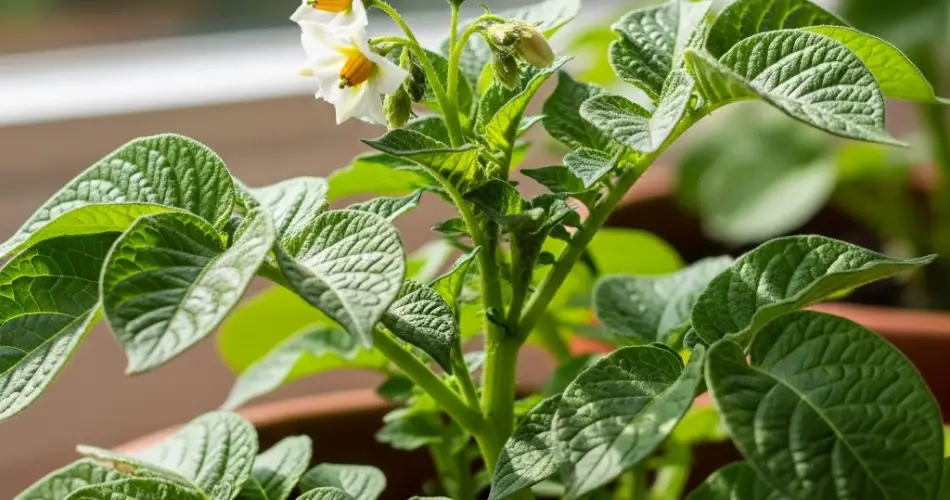Growing potatoes in containers is an excellent way to cultivate your own fresh and flavorful tubers, especially if you lack space for a traditional garden. Container potato growing allows you to control soil conditions, minimize pests, and harvest with ease—all without digging up an entire garden bed. Whether you’re a beginner or a seasoned gardener, this step-by-step guide will help you grow potatoes successfully in a compact space.
Why Grow Potatoes in Containers?
Potatoes thrive in loose, well-drained soil, which is easier to manage in containers. Growing them this way offers several benefits:
-
Space-saving: Ideal for patios, balconies, or small backyards.
-
Portable: Move containers to follow the sun or protect plants from frost.
-
Cleaner harvest: No need for tools—just dump out the soil.
-
Less weeding: Containers reduce weed problems significantly.
-
Pest control: Fewer issues with soil-borne diseases and pests like wireworms.
Choosing the Right Container
Select a container that is deep and wide enough to accommodate the growing tubers. The ideal size is at least 12–16 inches deep and 14–18 inches in diameter. Good options include:
-
Large plastic buckets or pails (with drainage holes)
-
Fabric grow bags
-
Recycled sacks or bins
-
Sturdy garbage cans with drilled holes
Ensure the container has sufficient drainage to prevent waterlogging, which can lead to rot.
Best Potato Varieties for Containers
Some potato varieties perform better in containers than others. Choose early or mid-season types, which produce smaller plants and quicker harvests. Good choices include:
-
Yukon Gold
-
Red Pontiac
-
Charlotte
-
Fingerling
-
Maris Piper
These varieties are known for their compact growth and high yields in confined spaces.
What You’ll Need
-
Seed potatoes (preferably certified disease-free)
-
Large container with drainage
-
Potting mix (loose, rich, and well-draining)
-
Compost or organic fertilizer
-
Watering can or hose with gentle spray
Avoid using regular garden soil, as it can be too dense and may contain pests or weed seeds.
Step-by-Step Planting Guide
1. Prepare the Seed Potatoes
Cut larger seed potatoes into chunks, making sure each piece has at least one “eye” or sprouting bud. Let them air dry for a day or two to reduce the risk of rot. Small seed potatoes can be planted whole.
2. Fill the Container
Add 4–6 inches of potting mix and compost blend to the bottom of the container. Mix in a slow-release organic fertilizer if desired.
3. Plant the Potatoes
Place 2–3 seed potato pieces on the soil surface, spaced evenly apart. Cover them with 4 inches of soil.
4. Water Thoroughly
Gently water the soil until it is evenly moist but not soaked. Keep the container in a sunny location with at least 6 hours of sunlight per day.
Ongoing Care
Hilling Up
As the potato plants grow and reach about 6–8 inches tall, add more soil or compost to cover the lower stems, leaving just the top few inches exposed. This is known as “hilling” and encourages more tubers to form along the buried stems. Repeat this process every 1–2 weeks until the container is full.
Watering
Potatoes need consistent moisture to develop properly. Water regularly, especially in hot or dry conditions. The soil should remain damp but not soggy.
Feeding
Supplement with liquid organic fertilizer every 2–3 weeks to support vigorous growth, particularly after flowering begins.
Signs of Maturity and Harvest
Potatoes are usually ready to harvest about 10–12 weeks after planting for early varieties. For baby potatoes, harvest shortly after flowering. For full-sized tubers, wait until the foliage turns yellow and begins to die back.
To harvest, simply tip the container over onto a tarp or large surface and sift through the soil to collect your potatoes. Rinse and allow them to dry before storing in a cool, dark place.
Common Issues and Troubleshooting
-
Green potatoes: Caused by sun exposure. Always keep developing tubers covered with soil.
-
Rotting: Avoid overwatering and ensure containers have proper drainage.
-
Low yield: Could be due to shallow soil, poor sunlight, or overcrowding. Hill regularly and space seed pieces appropriately.
Tips for Success
-
Don’t overcrowd your container—stick to 2–3 seed potatoes per large pot.
-
Avoid using sprouted supermarket potatoes, which may carry disease.
-
Use mulch on top to retain moisture and protect from temperature fluctuations.
-
Keep an eye on foliage health. Yellowing too early could indicate nutrient deficiencies or overwatering.
Final Thoughts
Container-grown potatoes offer a rewarding and space-efficient gardening experience. With just a few basic materials and regular care, you can enjoy a satisfying harvest of fresh, homegrown potatoes—no backyard required. Whether you prefer waxy fingerlings or fluffy bakers, growing potatoes in pots is a fun and productive project for any gardener.



